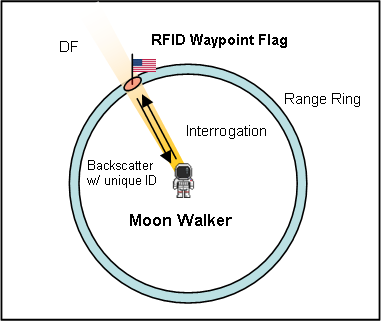Astro-Location
| RFID Waypoint | RFID Interrogator | Portable Array |
The
Lunar Astro-Track system utilizes a combination of radar and phased
array signal processing techniques. Specifically the radar
range equation and direction finding (DF) are used to lunar-locate the
RFID
Waypoint Flags.
Periodically, the astronaut RF system, sends out an interrogation burst
that has an adequate amount of power and duration to power the RFID
Waypoint to transmit a unique identifier pulse that is orthogonal to
other RFID waypoint pulses. This unique pulse is an
unmodulated gold code peudo-noise direct sequence spread spectrum
pulse. The astronaut RF system accurately time stamps the
interrogation pulse time and received waypoint pulse time.
Using these time values, a waypoint range ring is computed.
The thickness of the ring represents the timing uncertainty.
A waypoint or bread crumb pulse is detected with a bank of matched filters, each
behind a phased array antenna element. The relative phases of
the cross-correlation peaks represent an angle of which the waypoint
pulse came from. The array geometry and system phase noise
determine the 'angle thickness' of the angle estimate. With
this angle and the range ring, the waypoint can be accurately located
relative to the astonaut.

Why not use Receive Signal Strength (RSS) Techniques?
RSS requires a large accurate database of receive strength vs location.
For a mission on the moon, the amount of time and maticulous
measurement required for an accurate RSS radio location would be too
great. In addition, with realistic antenna
patterns, the orientation of the astronaut or RFID could
easily throw off RSS techniques..